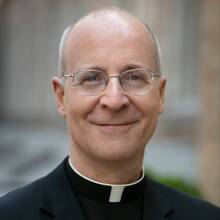 A meditation on the mosaic of Sts. Joachim and Anne--traditionally Mary's parents--by Marko Rupnik, SJ, which graces the Chapel at Sacred Heart University in Connecticut. This meditation ran in our Christmas issue last year.
A meditation on the mosaic of Sts. Joachim and Anne--traditionally Mary's parents--by Marko Rupnik, SJ, which graces the Chapel at Sacred Heart University in Connecticut. This meditation ran in our Christmas issue last year.
This is perhaps the most unexpected part of the Blessed Sacrament chapel: a touching depiction of Joachim and Anne, the traditional names of Mary’s parents. (The names appear in the apocryphal Gospel of James.) It is one of the tenderest portraits of a married couple I have ever seen.
How rare it is in a Christian setting to see a couple portrayed in such a clear demonstration of physical affection. Even when Mary and Joseph are depicted as a couple, they are seldom shown touching each other, lest the art challenge the viewer’s image of the couple’s chastity.
But Joachim and Anne led a full, married life and had at least one child, Mary. In Rupnik’s mosaic, they rejoice in the birth of their new grandchild and embrace, their faces pressed together in utter joy.
When I saw this mosaic, I thought of the verse often used at weddings, something their grandson would later say, as recorded in the Gospel of Mark: “The two shall become one flesh.” Perhaps Jesus knew his grandparents well and reflected on their love.
Joachim and Anne are one in love and devotion.
James Martin, SJ







